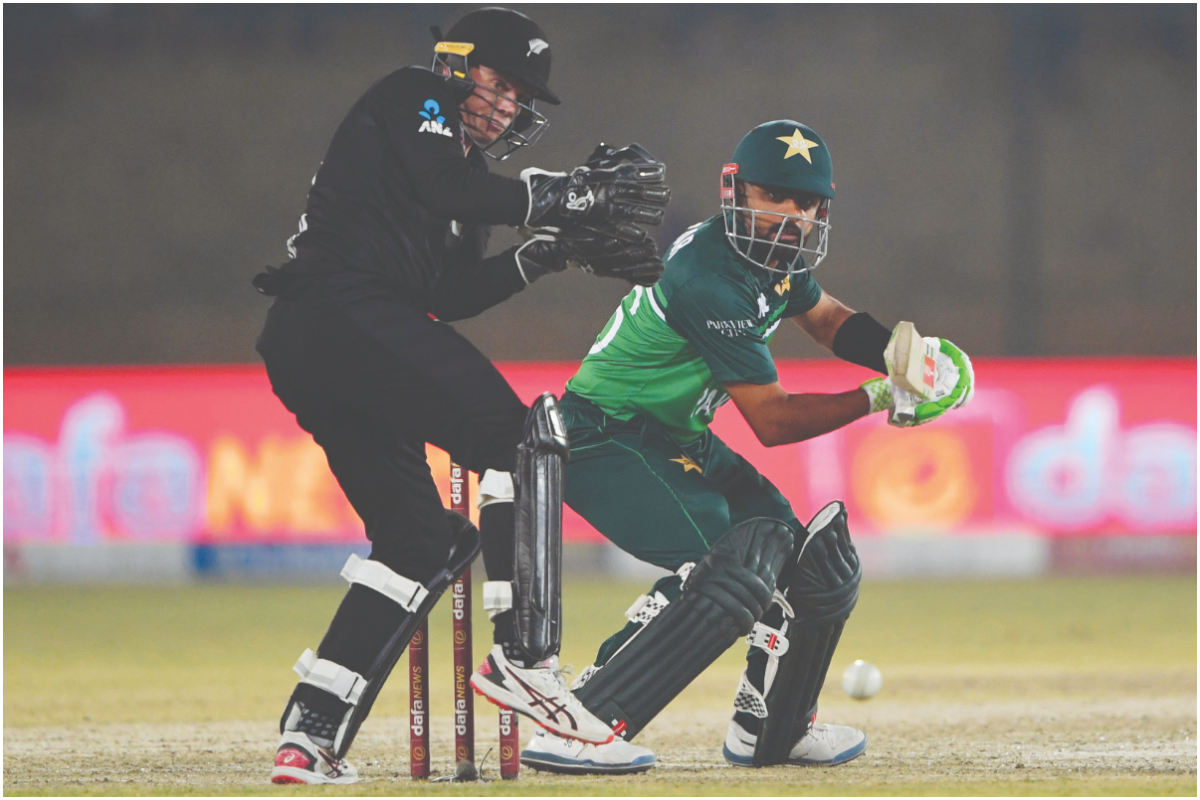
The Fault in our Plans
Pakistan’s defeat against NZ in the 2nd ODI has raised the same old questions regarding intent and imagination
As Pakistan crawled to their defeat in the second ODI against New Zealand mid of this week, questions were raised again about the lack of aggressiveness and imagination in Pakistan’s batting when they are faced with adversity.
Or when they find themselves on a bowling-friendly pitch against a penetrative and intelligent attack. There is this 90s-era style of batting that we see; an approach as outdated as a landline today.
Yes, it was a difficult pitch to bat on as the ball was turning square at times. All the more important it was for Babar to realize that it would get worse and for less experienced and less skilful batsmen who were to follow.
To take the game deep by him and Rizwan — as he said after the game — was the plan but then he assumed wickets wouldn’t fall. That has been the fallacy of the Pakistani chase strategy made worse when runs are dried from both ends.
Sure it’s an approach that has weight but it comes with certain other necessities, like ensuring the required run rate doesn’t climb, especially when the pitch is getting difficult by the over.
A shot that Babar eventually played off Sodhi near the end when the asking rate was approaching near 10, lifting a not-too-short ball over cover for six, is what he and Rizwan should have playing around the 15th over after settling down from the two early losses.
That policy of closing shop for adventurous shots after the fall of quick wickets is what Pakistan would do mostly through the 90s and it was Sarfaraz Ahmed who changed it a bit while he was captain as he would push for his batsmen to rotate the strike at least.
Recall how he manoeuvred to win against Sri Lanka in the last group game (virtual quarterfinal) of the 2017 Champions Trophy. Keep attacking and keep probing for runs no matter the loss of wickets at the other end.
However, that valour is missing today whether it is in the middle or in the coaches’ mind. They try it too late also if at all. Going by what batting coach Mohammad Yousuf revealed in a press conference during the second Test against New Zealand, the batters are not given any instruction on how to bat when they go in.
In the modern world of cricket where data is king and it’s all about mind games planned ahead or spontaneously, to leave it to the discretion of each individual is staggering to hear.
And so it seemed when Babar and Rizwan were batting. I don’t say it after the facts; I said so in my radio commentary as it was happening. Going at three an over on a turning pitch with three specialist spinners and a useful fourth and a target of over 250, it was clear that the run rate had to be better.
That there would be too much pressure on those coming after them. That none of the immediate followers was bold stroke players should have featured in their discussions mid-pitch.
In fact, when Imam was the second wicket to fall with the score in single digits, you needed a batter coming in who would rotate the strike and keep the scoreboard moving.
Rizwan doesn’t have that reputation or history. He also has the publicly stated policy that if he’s batting with Babar then he waits until he gets out to accelerate, as he did in the first ODI.
That is the frustrating part and harks back to the safety first methodology of many years ago; Inzamam-ul-Haq and Mohammad Yousuf were practitioners of that in the middle order. If you have Yousuf as the batting coach then that thinking will continue and it seems to be doing exactly that.
This means there is a flaw, not just in the action stage but in the pregame planning. You only have Fakhar as the modern-day white ball batter.
Imam, Babar, Rizwan and Haris Sohail who follow are all made of the same mould.
Put them up against a second-string attack and they will become bolder, as they did when chasing down 350 against Australia back in march, when none from Pat Cummins, Mitchell Starc, Josh Hazelwood and Nathan Lyons was in the bowling attack.
And of course on a bland pitch.
But put them up against a quality and experienced attack on a pitch that asks questions from them, then they go into the mundane tactic of slow and steady that has selfish undercurrents.
If Babar and Rizwan have this overprotective approach and this thinking that there is no hope if they get out, then it does become a self-fulfilling prophecy.
The batters waiting to come in can sense that, especially when the coaches sitting next to them seem to agree with Babar and Rizwan and their combined approach.
Look it was as much Haris Sohail’s quickfire 32 as half-centuries from Rizwan and Babar that sealed the first game. Otherwise, the pace at which Babar and Rizwan scored their runs would have proved inadequate even though they were coming at a reasonable rate.
But in the second game, Haris seemed to be overawed which I feel was mainly because of what he was seeing from the dressing room; the discomfort with which Babar and Rizwan were batting in the middle. As such he too showed none of the boldness of his first game, when he twice lifted Southee to the boundary off a good length.
Coming to the planners, they have to see that they are sending in the same mindset from Nos 3 to 5, maybe even 6 as Salman Agha is not really a high-risk taker.
They need at least two batsmen there who would go for their strikes and take risks. This was a target of 262; imagine how they would struggle when it is 300-plus and the bowling is of world standard.
I admit again that it was difficult to go for the shots on a turning pitch and three spinners operating. But to go back to the six that Babar smashed over extra cover off Sodhi is what had to be the approach from very early on.
There was talk that Pakistan did not read the pitch and played three seamers whereas New Zealand dropped one from the previous game and played two.
But that was because Pakistan were already playing a third spinner in Salman Agha and there wasn’t another spinner in the squad of 16.
That Kane Williamson and Devon Conway made that third option irrelevant was due to their audaciousness against Salman, something that Babar and Rizwan refused to do. Remember New Zealand too had lost their belligerent Finn Allen early on; that Pakistan lost two early on was marginally more worrisome.
But what Babar could have done was to try himself on or throw the ball to Haris Sohail, who has been a crafty left-arm spinner. Williamson brought on Greg Philips in both games; in the second when he already had three specialist spinners.
The ball had already started to spin and there was no harm in accepting that the seamers were not getting the better of Williamson and Conway. That is where I feel Babar is too conservative and doesn’t experiment enough. And in time.
As I write this from the ground after the lights are dimmed at the conclusion of the presentation ceremony of the second game, I fear that with the series level, Pakistan are unlikely to give an opportunity to the young Tayyab Tahir and Kamran Ghulam.
I would play one of them certainly even with the series win at stake. How important is it to win a series of no consequence than it is to test out these high performers at the domestic level on the international stage.

As it is it is just one game on the line and then on to April-May when the Kiwis return to Pakistan for more white-ball cricket.
There was the thinking in fact that Haris Sohail should not have been recalled at all and that Kamran or Tayyab should have been in the planning of the first XI from the start.
That with 129 runs in four games in the Pakistan Cup (the national One Day competition), he had not done as much to earn a recall to the side.
I actually had backed his return though but that was because I thought he was being played as spinning all-rounder.
Though he batted boldly and confidently in that first game, but honestly, if you’re not going to bowl him, then this opportunity of a specialist batsman should have gone to those who have scored a lot of runs in the Pakistan Cup over the last couple of years. I hope it’s gone to one of the two in the third game. Or will when the New Zealanders return in the spring.
I also hope that Haris Rauf has been rested for the third ODI. I say this because I feel he is not fully fit. All through that second game he never once crossed 145km/hr on any of his deliveries; he normally starts and even ends with 150.
Not that bowling in the 140s is not good enough, just that if he’s not bowling at less than his normal speed means something is holding him back and it could only be the muscle he pulled in that Pindi Test against England.
I honestly don’t get why we rush back injured players into the international without first asking them to play in the domestic tournament. And if he wasn’t fit to play then that don’t test him in an ODI.
The fighter that he is and the way he continued to dive and run in fielding he could still have ended up with five wickets on Friday if played. But it would serve him and Pakistan both if one from Dahani or Hasnain played. Or if the pitch is deemed to be turning again then what’s the harm in calling in Abrar from outside the squad?

As it is I can’t get why for the home series we announce squads in advance. We simply lose the advantage of playing at home and having so many options at our disposal.
Just have players practising at the Academy at the Gaddafi Stadium or even here in Karachi and call up anyone you want. It happens that way in the English summer for the England side and in Australia too. But we always paint ourselves in the corner at our own home.
Sohaib Alvi has been covering cricket at home and abroad for over 40 years as columnist, editor, analyst, TV expert/host. An MBA from IBA he has simultaneously had a 35-year career in the corporate sector, having worked in C-Suite positions. He now advises clients on leadership, business strategy, marketing and organizational planning.
Catch all the Champion News, Breaking News Event and Latest News Updates on The BOL News
Download The BOL News App to get the Daily News Update & Live News.












 Read the complete story text.
Read the complete story text. Listen to audio of the story.
Listen to audio of the story.